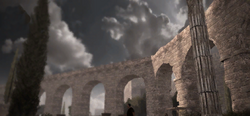
|
Ezio, my friend! How may I be of service? This article is in desperate need of a revamp. Please improve it in any way necessary in order for it to achieve a higher standard of quality in accordance with our Manual of Style. |
Aqueducts were stone structures found throughout the former Roman Empire. They provided fresh water to the different baths, fountains and households of the ancient cities. Sizeable networks existed in the cities of Rome and Constantinople; the majority of these aqueducts in Rome, however, were in states of disrepair due to Borgia rule during the Renaissance.
During the liberation of Rome, the Assassin Ezio Auditore da Firenze restored the aqueducts and cleared Borgia influence from around the structures.
Roman aqueducts
Acquedotto Claudia

The Acquedotto Claudia
The Acquedotto Claudia was an aqueduct that was found in Rome in the Antico district. Like many of the aqueducts found in Rome, this Aqueduct was in a state of disrepair. When Ezio came to Rome, he paid Architects to renovate all four broken sections of the aqueduct.
Acqua Vergene
The Acqua Vergene was the smallest of the aqueducts, with only one section that was renovated in Rome. It was located in the Northern side of the Campagna district.
Acqua Marcia
The Acqua Marcia was an aqueduct that could be found in the Campagna district, once supplying the Terme di Diocleziano with water. There were three broken sections that could be renovated on it.
Acqua Antoniniana
The Acqua Antoniniana was built as a secondary channel from the Acqua Marcia. It was found in the Southern side of the Antico district just between the Terme di Caracalla and the Mura Aureliane.
Ottoman aqueducts
Valens Aqueduct
The Valens Aqueduct was a Roman aqueduct in Constantinople and a major city landmark, completed in the 4th century CE. It was restored primarily by Sultan Bayezid II and several other Sultans.
Trivia
- Even when Ezio had finished renovating the broken aqueducts, the map still displayed their locations and they were still referred to as broken aqueducts.
